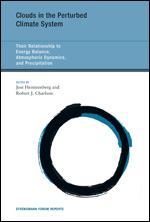Justification
Extensive water and ice clouds are a unique feature of our planet. On average, more than half of the globe is covered by visible clouds. They control major parts of the energy balance of the Earth system, both with respect to the incoming short-wave solar radiation and the outgoing long-wave thermal radiation. Latent heating and cooling related to cloud processes modify the atmospheric circulation. By modulating sea surface temperatures, clouds affect oceanic circulation as well. Clouds are an essential component of the global water cycle, on which all terrestrial life depends.
Humankind is perturbing the Earth's cloud system through industrial activities and surface changes. Regionally, the most obvious (but not necessarily most relevant) perturbations are the frequently visible contrails resulting from aircraft emissions. Anthropogenic cloud perturbations can even be seen from space through ship tracks in persistent low marine clouds. The main recognized mechanisms of anthropogenic perturbations of clouds are:
- Effect of pollution aerosols on cloud droplet concentration, leading to (i) an increase of the cloud optical thickness and (ii) a reduced precipitation efficiency, hence an increase of the cloud life time and coverage.
- Effect of absorption of solar radiation by aerosol particles on the thermal structure of the cloud-topped boundary layer.
- Effect of greenhouse gases on atmospheric dynamics and subsequent cloud formation, the water vapor feedback, and cloudiness.
- Modification of the hydrologic cycle by modification of land surfaces and ocean circulation.
- Deliberate modification of clouds.
In the current climate epoch, clouds are the dominant controllers of the albedo of Earth because of their high reflectivity for sunlight, or albedo (ca. 0.5), and their geographical coverage (over 50%). Along with greenhouse gases (CO2, CH4, etc.), clouds play a major role in the control of outgoing long-wave radiation (OLR). Because of the enormous emphasis and effort devoted to greenhouse gases, their concentrations are accurately monitored and their climate forcing is now precisely predicted. In contrast, clouds are still poorly represented in climate models, and parameterizations of their various feedbacks on the climate system are still missing. Despite the generally accepted importance of clouds for the Earth system and their high susceptibility to anthropogenic forcings, our knowledge of the spatio-temporal cloud distribution is poor. Global cloud climatologies are under development but are far from definitive. The total effect of clouds on the energy balance is highly uncertain. The counteracting short- and long-wave radiative effects of clouds as functions of time and space are not well understood. In terms of numerical weather prediction, forecast skills are lowest for clouds and precipitation; significant progress has not been achieved over the past decade. Whereas human effects on clouds can be clearly discerned in a few extreme cases, the subtle but much more important large-scale and long-term effects of anthropogenic emissions are incredibly difficult to separate from the inherent high variability of cloud properties. Even the definition of what clouds are can be debated. The textbook definition states that clouds are "visible aggregations of minute water and ice particles." Also visible are haze aerosols — even from space — with ensuing global effects on the energy balance. Hygroscopic aerosol growth below 100% relative humidities causes a continuum of atmospheric hydrometeors reaching from dry aerosols to what are traditionally called clouds. Presently, we lack the necessary sensitive and globally available instrumentation. Also, techniques for transferring small-scale measurements to larger scales are missing. Clouds thus remain the largest source of uncertainty in the prediction of climate change.
There are solid reasons for our very limited knowledge of clouds and related processes. Clouds involve spatial scales from sub-millimeter to hemispheric and temporal scales from sub-second to seasonal. Thus, cloud climatologies ideally require three-dimensional global monitoring systems, and these are not presently available. Clouds also comprise the most complex geophysical multiphase systems in which microphysical, chemical, dynamic, and radiative processes need to be considered concurrently. Thus, the totality of cloud processes requires multidisciplinary analytical systems that do not yet exist, at least not for each cloud environment, with all the necessary sensitivities and resolutions. The space-borne possibilities for cloud studies that are required for global monitoring can only address a very limited subset of cloud parameters necessitating complementary in situ investigations.
To meet this challenge, we propose this Forum to assess the limits of our understanding of clouds and anthropogenic perturbations of them and to formulate strategies for reducing the critical uncertainties. The interdisciplinary character of an Ernst Strüngmann Forum offers a unique opportunity for critical assessments of present knowledge concerning a highly complex key issue in the discussion of global change. This assessment is urgently needed to delineate future research directions.
Top of page
![]()
